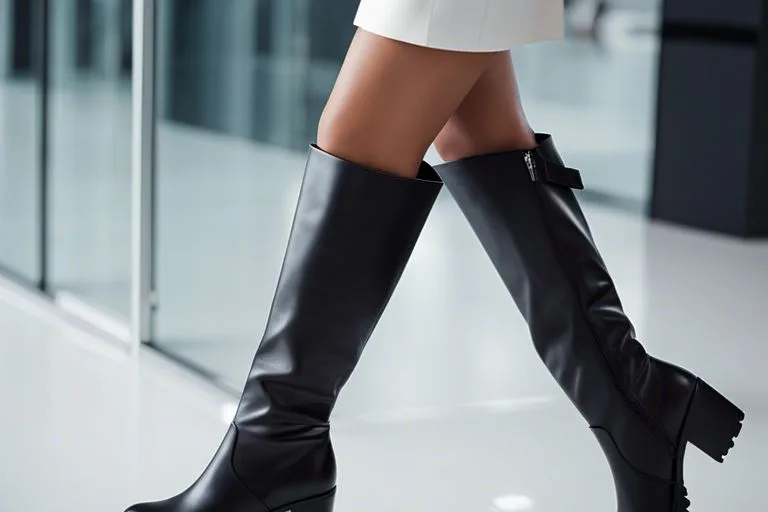Evaluating the appropriateness of knee high boots for the workplace involves considering a variety of factors. While knee high boots can be a fashionable and versatile addition to your wardrobe, it’s important to assess whether they align with the professional expectations of your workplace. In this blog post, we will delve into the dos and don’ts of wearing knee high boots to work, and provide you with the necessary guidance to make an informed decision on this matter.
When it comes to workplace attire, professionalism and appropriateness should be your top priority. Knee high boots can be a powerful fashion statement, but they may also carry the risk of appearing too casual or distracting in a professional environment. It’s important to consider the company’s dress code, the nature of your role, and the specific tasks and interactions you’ll be engaging in throughout the workday. All of these factors will determine whether knee high boots are a suitable choice for your workplace attire.
Key Takeaways:
- Company dress code: Before wearing knee-high boots to work, it is important to consider the company’s dress code. Some workplaces may have strict guidelines on appropriate footwear, while others may have more lenient policies.
- Professionalism: Knee-high boots can be appropriate for work if styled in a professional manner. Pairing them with tailored clothing and sticking to neutral colors can elevate their look and maintain a professional appearance.
- Comfort and practicality: Considering the comfort and practicality of knee-high boots is essential. If your job requires a lot of walking or standing, it may be wise to opt for a lower heel or choose a more comfortable style to ensure functionality in the workplace.
Historical Context of Boots in Fashion
Assuming you are considering knee-high boots for work, it’s important to understand the historical context of boots in fashion. Boots have been a staple in wardrobes for centuries, with evidence of their use dating back to ancient civilizations. In the context of workwear, boots have often been practical and functional, offering protection and support in various labor-intensive environments. As fashion evolved, boots became a symbol of style and status, influencing trends across different eras.
Evolution from Function to Fashion
Boots were initially designed for practicality, offering protection and support in harsh working conditions. Over time, they evolved to incorporate elements of fashion, with embellishments and decorative elements reflecting the prevailing trends. The transition from function to fashion allowed boots to become a versatile accessory, suitable for both work and leisure. The incorporation of different materials and design elements further cemented boots as a fashion statement, with practicality being complemented by style.
Knee-High Boots Through the Decades
Throughout history, knee-high boots have made a significant impact on fashion trends. In the 1960s, they were popularized as a symbol of rebellion and empowerment, particularly among women. The bold and daring nature of knee-high boots became synonymous with individuality and self-expression. In subsequent decades, knee-high boots continued to be a focal point of fashion, with designers reinterpreting them to suit the evolving trends. Their enduring presence in fashion highlights their versatility and timeless appeal, making them a staple in any wardrobe.
Knee-High Boots as Professional Attire
Even though knee-high boots have traditionally been associated with casual wear, they can also be a stylish addition to your work wardrobe. When styled correctly, they can be a sophisticated and professional choice for the office. If you’re unsure about how to wear tall boots to the office, you can find some helpful tips and inspiration here.
General Perceptions in the Workplace
When it comes to wearing knee-high boots to work, general perceptions in the workplace can vary. While some may view them as too casual or inappropriate for a professional setting, others see them as a fashionable and contemporary choice. It’s important to consider your company’s dress code and the overall culture of your workplace when deciding whether knee-high boots are appropriate for you.
Keep in mind that knee-high boots with stiletto heels or bold, statement-making details may be seen as less professional than a classic, streamlined pair. Be mindful of how the style and design of the boots can influence the way they are perceived in the workplace.
Industry-Specific Acceptance
Depending on the industry you work in, knee-high boots may be more or less accepted as part of professional attire. In creative or fashion-forward industries, there may be more flexibility when it comes to incorporating stylish footwear choices into your work outfits. On the other hand, in more conservative or traditional fields, knee-high boots may be viewed with more skepticism.
It’s essential to consider the specific expectations of your industry and your workplace when deciding whether knee-high boots are appropriate for you. While some industries may embrace bold and fashion-forward choices, others may require a more conservative approach to dressing for work.
The Influence of Corporate Dress Codes
Your workplace’s dress code plays a significant role in determining whether knee-high boots are appropriate for work. Corporate dress codes vary widely, and understanding the rules and expectations is crucial to your professional image.
Understanding Formal and Casual Dress Codes
Formal dress codes typically require conservative and traditional attire, such as suits, dress shirts, and closed-toe shoes. In contrast, casual dress codes allow for more relaxed and comfortable clothing, such as slacks and polo shirts. Understanding the distinction between these dress codes is essential for determining whether knee-high boots are a suitable choice for your workplace.
It’s important to note that some companies have specific guidelines outlined for what is considered acceptable attire, providing clarity on where knee-high boots fit into the dress code. When in doubt, refer to your company’s employee handbook or consult with HR to gain a clear understanding of the expectations for professional attire in your workplace.
Interpretation of Dress Codes Regarding Boots
When it comes to interpreting dress codes concerning footwear, the appropriateness of knee-high boots can be subjective. Some companies may view knee-high boots as a trendy and fashionable addition to a professional outfit, while others may see them as too casual or distracting for the workplace environment.
Ultimately, your interpretation of the dress code regarding knee-high boots should consider the culture and norms of your workplace. Some industries may be more open to individual expression through fashion, while others may prioritize a more traditional and conservative appearance. It’s essential to weigh the potential impact of your footwear choice on your professional image and the perception of your colleagues and superiors.
The Role of Material and Design in Professionalism
To make knee high boots appropriate for work, it’s important to consider the material and design of the boots. The right choice can add professionalism to your outfit, while the wrong one can make your look too casual for the workplace. Here’s what to consider when choosing knee high boots for work.
Leather, Suede, and Synthetic Options
When it comes to material, leather is the most professional option for knee high boots. It’s durable, sleek, and conveys a sense of sophistication. Suede can also be appropriate for work, but it’s important to choose a high-quality, well-maintained suede to avoid looking too casual. Synthetic materials, while often more affordable, can give off a less polished look and may not be suitable for all professional environments.
Boot Shape, Heel Height, and Decorative Elements
The shape of the boot, the heel height, and any decorative elements should also be considered when determining whether knee high boots are appropriate for work. Opt for a classic, streamlined shape that complements your professional attire. Avoid overly slouchy or embellished designs. When it comes to heel height, a modest, stable heel is the most practical and professional choice. Avoid extremely high heels or overly chunky styles, as they can be distracting and may not be suitable for all work environments.
Color and Styling for Knee-High Boots at Work
After determining that knee-high boots are appropriate for your workplace, it’s time to consider the color and styling options that will complement your work attire. The choice of color and how you style your knee-high boots can make a significant impact on your overall professional look.
The Psychology of Color in Work Attire
When it comes to work attire, color psychology plays a crucial role in how you are perceived by others. Darker colors such as black, brown, or navy convey a sense of authority and professionalism, making them ideal choices for knee-high boots in a professional setting. On the other hand, bold and bright colors can make a statement but may not always be suitable for a conservative work environment. When choosing the color of your knee-high boots, consider the message you want to convey and how it aligns with your work environment.
Styling Boots With Different Outfits
Styling knee-high boots with different outfits for work can be a versatile and chic option. For a sophisticated look, pair your knee-high boots with tailored pants or a pencil skirt. This combination not only elongates your silhouette but also exudes a polished and put-together vibe. If you prefer a more relaxed look, consider pairing your knee-high boots with a knee-length dress or a flowing skirt. The key is to find a balance between professionalism and personal style, ensuring that your outfit is both appropriate and flattering for the workplace.
Managing Comfort and Practicality
Ergonomics and Long-term Wear
Keep in mind that knee-high boots can be stylish, but they should also be comfortable and practical for daily wear. Consider the ergonomics of the boots, such as the heel height, arch support, and cushioning. Look for boots with a sturdy and supportive sole to provide proper alignment and reduce the risk of foot and back pain. Additionally, make sure the boots fit properly to avoid rubbing, blisters, and discomfort. You want to prioritize comfort and support, especially if you’ll be on your feet for long periods at work.
Seasonal Considerations for Knee-High Boots
When determining if knee-high boots are appropriate for work, consider the seasonal factors. In colder months, knee-high boots can provide warmth and protection from the elements, making them a practical choice. However, in warmer weather, they can be too hot and uncomfortable, especially if your workplace lacks adequate air conditioning. You may want to reserve knee-high boots for the fall and winter months and opt for more breathable footwear in the spring and summer. This seasonal approach ensures that you stay comfortable and appropriate in all work settings.

Navigating Social and Cultural Dynamics
Despite the increasing acceptance of knee-high boots in professional settings, it’s essential to navigate the social and cultural dynamics surrounding workplace attire. Different workplaces may have varying expectations, and it’s important to consider the overall professional ambiance of your office. According to Ask A Manager, knee-high boots can be appropriate in business casual settings, but it ultimately depends on your specific workplace culture.
The Balance Between Personal Expression and Professionalism
When considering knee-high boots for the workplace, finding the balance between personal expression and professionalism is crucial. While you may want to express your personal style, it’s important to ensure that your attire aligns with professional norms in your industry. You can still incorporate knee-high boots into your work outfits, but it’s crucial to pair them with other professional attire to maintain a polished look. Your attire should reflect both your individuality and a professional image, striking a balance between personal expression and workplace expectations.
Cross-Cultural Perspectives on Boots in the Workplace
In some workplaces, there may be cross-cultural perspectives on wearing boots in a professional environment. While knee-high boots may be widely accepted in certain regions or industries, they could be viewed as unconventional or informal in others. It’s important to consider the cultural dynamics at play in your workplace and industry. Being cognizant of differing cultural perspectives can help you make informed decisions about incorporating knee-high boots into your work attire. Remember that your attire should conform to professional standards while respecting the cultural norms of your workplace.

Conclusion
Considering all points, it is clear that knee high boots may not be the most appropriate choice for work. While they may be stylish and fashionable, they can often be seen as too casual or even unprofessional in a formal work setting. This is particularly important to keep in mind if you work in a traditional or conservative industry. It is always essential to consider the dress code and expectations of your workplace when choosing footwear, and knee high boots may not align with these standards.
Opting for more traditional and professional footwear such as closed-toe pumps or ankle boots may be a better choice for the workplace. This can help you maintain a polished and put-together look while also adhering to the professionalism expected in a work environment. Ultimately, while knee high boots can be a great choice for many occasions, it is important to consider the appropriateness of such footwear in a work setting, and to choose your footwear accordingly.
FAQ
Q: Are knee high boots appropriate for work?
A: It depends on the workplace dress code and the style of the boots. In some professional settings, knee high boots may be considered inappropriate, while in others, they can be acceptable attire.
Q: How can I determine if knee high boots are appropriate for my workplace?
A: Check your company’s dress code policy or ask your HR department for guidelines on appropriate footwear. Consider the overall professional image of the workplace and the nature of your job responsibilities.
Q: What styles of knee high boots are generally considered appropriate for work?
A: Classic, understated styles like black or brown leather knee high boots with minimal heel height are often more suitable for work environments. Avoid overly flashy or provocative designs.
Q: Are there any specific dress codes I should be aware of when wearing knee high boots to work?
A: Some workplaces may have specific guidelines regarding the height of the boot shaft, heel height, or the presence of embellishments such as buckles or zippers. Always adhere to these dress code requirements.
Q: Are there any industries or professions where knee high boots are generally more acceptable for work?
A: In fashion-forward or creative industries, knee high boots are often more acceptable as part of a stylish and professional wardrobe. However, it’s still important to ensure that the style of the boots aligns with the overall workplace dress code.

